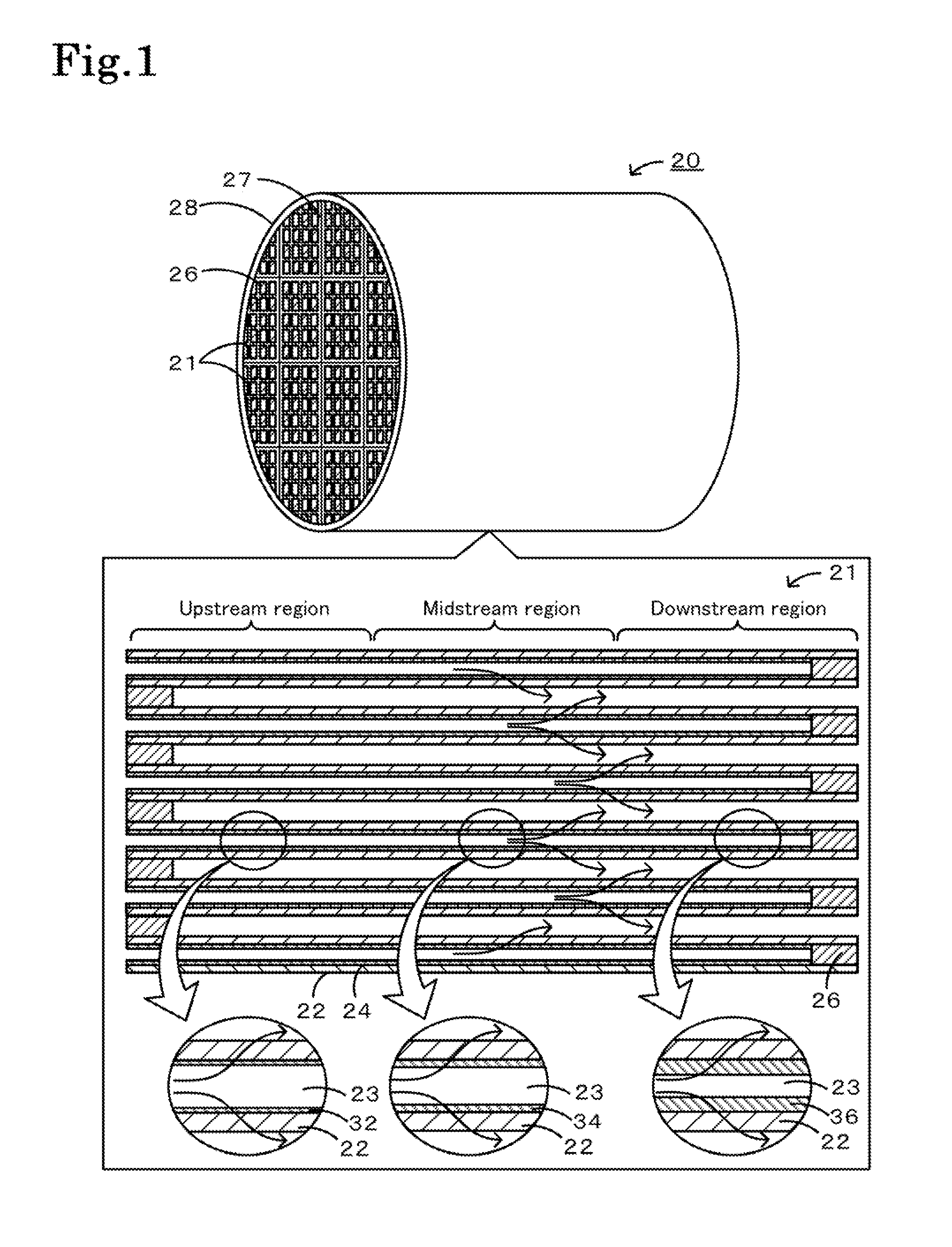Honeycomb filter
a technology of honeycomb and filter, applied in the field of honeycomb filter, can solve the problems of increasing the amount of pm deposit in the downstream region, temperature rise, etc., and achieve the effect of facilitating the removal of trapped solid components and increasing the mechanical strength of the honeycomb filter
- Summary
- Abstract
- Description
- Claims
- Application Information
AI Technical Summary
Benefits of technology
Problems solved by technology
Method used
Image
Examples
examples
[0060]Specific examples of the manufacture of a honeycomb filter will be described below. A honeycomb filter including honeycomb segments joined together was manufactured.
[0061][Manufacture of Honeycomb Filter]
[0062]A SiC powder and a metallic Si powder were mixed at a mass ratio of 80:20. Methylcellulose, hydroxypropoxylmethylcellulose, a surfactant, and water were added to the mixture, which was then kneaded to prepare a plastic pug. The pug was extruded through a die to form a honeycomb segment formed product having a desired shape. The thickness of the partition portion was 305 μm, the cell pitch was 1.47 mm, the cross section was 35 mm×35 mm, and the length was 152 mm. The honeycomb segment formed product was dried using a microwave and then with hot air, was sealed, was calcined in an oxidizing atmosphere at 550° C. for three hours, and was baked in an inert atmosphere at 1400° C. for two hours. The sealing portions were formed by masking alternate cell openings of the segment...
examples 1 to 4
[0068]The amounts of alcohol solution and SiC particles supplied were adjusted such that the upstream thickness th was 3.7 μm, the midstream thickness tm was 3.9 μm, and the downstream thickness t1 was 7.4 μm. The resulting honeycomb filter was referred to as Example 1. In Example 1, the maximum thickness tmax was 7.6 μm, the film thickness ratio Y1 was 2.0, and the film thickness ratio Y2 was 1.6. In Examples 1 to 4 and Comparative Examples 3 to 5, the average thickness tAve was 5 μm. The amounts of alcohol solution and SiC particles supplied were adjusted such that the upstream thickness th was 1.8 μm, the midstream thickness tm was 3.1 μm, and the downstream thickness t1 was 11 μm. The resulting honeycomb filter was referred to as Example 2. In Example 2, the maximum thickness tmax was 14 μm, the film thickness ratio Y1 was 4.5, and the film thickness ratio Y2 was 2.6. The amounts of alcohol solution and SiC particles supplied were adjusted such that the upstream thickness th was...
examples 5 to 8
[0070]The amounts of alcohol solution and SiC particles supplied were adjusted such that the upstream thickness th was 14 μm, the midstream thickness tm was 18 μm, and the downstream thickness t1 was 28 μm. The resulting honeycomb filter was referred to as Example 5. In Example 5, the maximum thickness tmax was 38 μm, the film thickness ratio Y1 was 1.8, and the film thickness ratio Y2 was 1.9. In Examples 5 to 8 and Comparative Examples 6 to 8, the average thickness tmax was 20 μm. The amounts of alcohol solution and SiC particles supplied were adjusted such that the upstream thickness th was 10 μm, the midstream thickness tm was 13 μm, and the downstream thickness t1 was 38 μm. The resulting honeycomb filter was referred to as Example 6. In Example 6, the maximum thickness tmax was 45 μm, the film thickness ratio Y1 was 3.3, and the film thickness ratio Y2 was 2.2. The amounts of alcohol solution and SiC particles supplied were adjusted such that the upstream thickness th was 5.2 ...
PUM
| Property | Measurement | Unit |
|---|---|---|
| thickness tp | aaaaa | aaaaa |
| thickness tp | aaaaa | aaaaa |
| thickness tAve | aaaaa | aaaaa |
Abstract
Description
Claims
Application Information
 Login to View More
Login to View More - R&D
- Intellectual Property
- Life Sciences
- Materials
- Tech Scout
- Unparalleled Data Quality
- Higher Quality Content
- 60% Fewer Hallucinations
Browse by: Latest US Patents, China's latest patents, Technical Efficacy Thesaurus, Application Domain, Technology Topic, Popular Technical Reports.
© 2025 PatSnap. All rights reserved.Legal|Privacy policy|Modern Slavery Act Transparency Statement|Sitemap|About US| Contact US: help@patsnap.com



